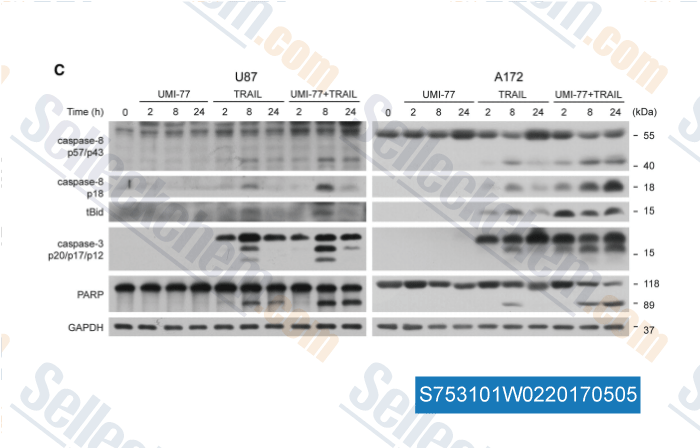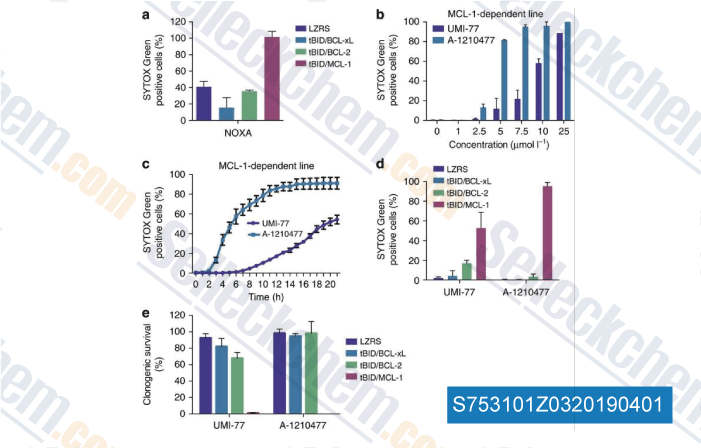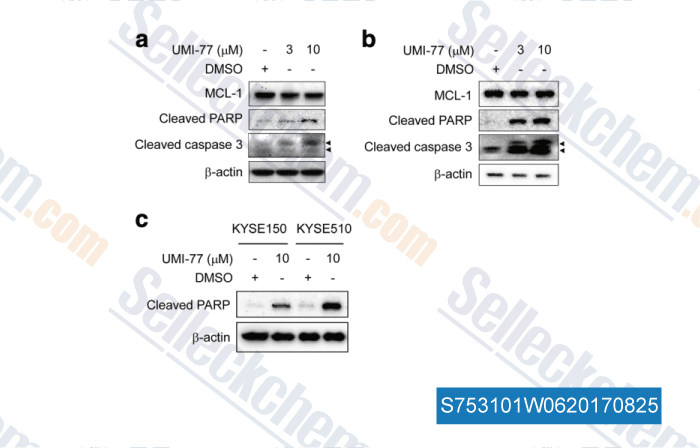|
Toll Free: (877) 796-6397 -- USA and Canada only -- |
Fax: +1-832-582-8590 Orders: +1-832-582-8158 |
Tech Support: +1-832-582-8158 Ext:3 Please provide your Order Number in the email. |
Technical Data
| Formula | C18H14BrNO5S2 |
||||||||||
| Molecular Weight | 468.34 | CAS No. | 518303-20-3 | ||||||||
| Solubility (25°C)* | In vitro | DMSO | 93 mg/mL (198.57 mM) | ||||||||
| Ethanol | 93 mg/mL (198.57 mM) | ||||||||||
| Water | Insoluble | ||||||||||
| In vivo (Add solvents to the product individually and in order) |
|
||||||||||
|
* <1 mg/ml means slightly soluble or insoluble. * Please note that Selleck tests the solubility of all compounds in-house, and the actual solubility may differ slightly from published values. This is normal and is due to slight batch-to-batch variations. * Room temperature shipping (Stability testing shows this product can be shipped without any cooling measures.) |
|||||||||||
Preparing Stock Solutions
Biological Activity
| Description | UMI-77 is a selective Mcl-1 inhibitor with Ki of 490 nM, showing selectivity over other members of Bcl-2 family. | ||
|---|---|---|---|
| Targets |
|
||
| In vitro | UMI-77 effectively disrupts the interactions between BL-Noxa and cellular Mcl-1, as well as Mcl-1/Bax protein–protein interactions. [1] This compound inhibits growth of pancreatic cancer cells with IC50 of 3.4, 4.4, 12.5, 16.1, and 5.5 μM for BxPC-3, Panc-1, MiaPaCa-2, AsPC-1 and Capan-2 cells, respectively. It induced apoptosis in pancreatic cancer through activation of the intrinsic apoptotic pathway and/or Bax conformational change. [1] | ||
| In vivo | In a BxPC-3 xenograft mouse model, UMI-77 (60 mg/kg i.v.) exhibits single-agent antitumor activity without any damage normal tissues. [1] |
Protocol (from reference)
| Kinase Assay: |
|
|---|---|
| Cell Assay: |
|
| Animal Study: |
|
References
|
Customer Product Validation

-
, , Mol Cell Biochem, 2017, 432(1-2):55-65

-
Data from [ , , Nat Commun, 2016, 7:10538 ]

-
Data from [ , , BMC Cancer, 2017, 17(1):449 ]
Selleck's UMI-77 Has Been Cited by 22 Publications
| Therapy-induced normal tissue damage promotes breast cancer metastasis [ iScience, 2024, 27(1):108503] | PubMed: 38161426 |
| Deregulation and epigenetic modification of BCL2-family genes cause resistance to venetoclax in hematologic malignancies [ Blood, 2022, blood.2021014304] | PubMed: 35704690 |
| Proteogenomics refines the molecular classification of chronic lymphocytic leukemia [ Nat Commun, 2022, 13(1):6226] | PubMed: 36266272 |
| Proteogenomics refines the molecular classification of chronic lymphocytic leukemia [ Nat Commun, 2022, 13(1):6226] | PubMed: 36266272 |
| AXL/MERTK inhibitor ONO-7475 potently synergizes with venetoclax and overcomes venetoclax resistance to kill FLT3-ITD acute myeloid leukemia [ Haematologica, 2021, 10.3324/haematol.2021.278369] | PubMed: 34732043 |
| Development of potent and selective inhibitors targeting the papain-like protease of SARS-CoV-2 [ Cell Chem Biol, 2021, S2451-9456(21)00213-0] | PubMed: 33979649 |
| Mesothelioma Cells Depend on the Antiapoptotic Protein Bcl-xL for Survival and Are Sensitized to Ionizing Radiation by BH3-Mimetics. [ Int J Radiat Oncol Biol Phys, 2020, 15;106(4):867-877] | PubMed: 31786278 |
| Targeting the Synthetic Vulnerability of PTEN-Deficient Glioblastoma Cells with MCL1 Inhibitors [ Mol Cancer Ther, 2020, 19(10):2001-2011] | PubMed: 32737157 |
| AT101 [(-)-Gossypol] Selectively Inhibits MCL1 and Sensitizes Carcinoma to BH3 Mimetics by Inducing and Stabilizing NOXA [ Cancers (Basel), 2020, 12(8):E2298] | PubMed: 32824203 |
| Alveolar Macrophage Apoptosis-associated Bacterial Killing Helps Prevent Murine Pneumonia. [ Am J Respir Crit Care Med, 2019, 200(1):84-97] | PubMed: 30649895 |
RETURN POLICY
Selleck Chemical’s Unconditional Return Policy ensures a smooth online shopping experience for our customers. If you are in any way unsatisfied with your purchase, you may return any item(s) within 7 days of receiving it. In the event of product quality issues, either protocol related or product related problems, you may return any item(s) within 365 days from the original purchase date. Please follow the instructions below when returning products.
SHIPPING AND STORAGE
Selleck products are transported at room temperature. If you receive the product at room temperature, please rest assured, the Selleck Quality Inspection Department has conducted experiments to verify that the normal temperature placement of one month will not affect the biological activity of powder products. After collecting, please store the product according to the requirements described in the datasheet. Most Selleck products are stable under the recommended conditions.
NOT FOR HUMAN, VETERINARY DIAGNOSTIC OR THERAPEUTIC USE.
